
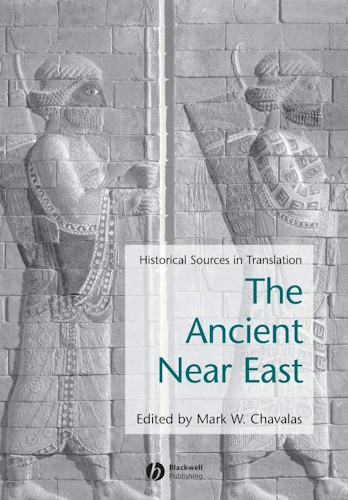

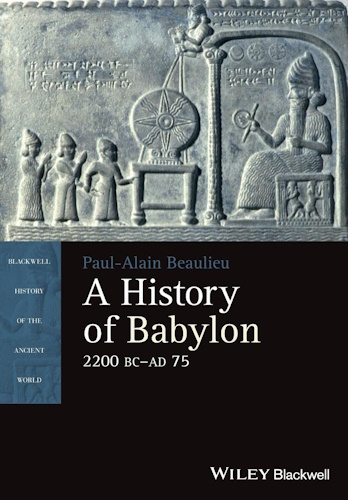

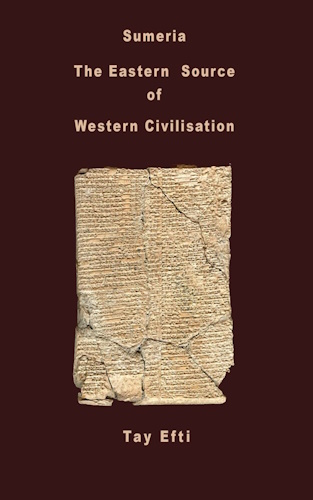



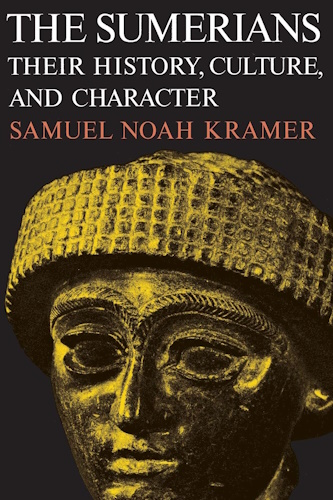

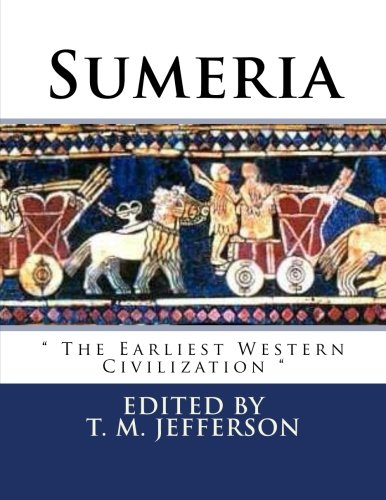

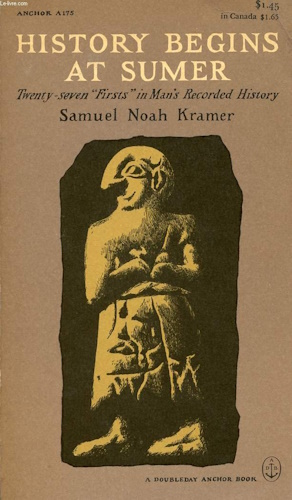

Code of Ur-Nammu
Code of Ur-Nammu
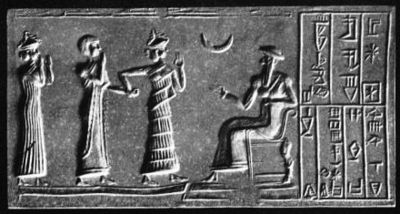
Ur-Nammu (seated) bestows governorship on Ḫašḫamer, patesi (high priest) of Iškun-Sin
(cylinder seal impression, ca. 2100 BC). Ur-Nammu was the husband of Inanna.
Code of Ur-Nammu
The Code of Ur-Nammu is the oldest known tablet containing a law code surviving today. It was written in the Sumerian language circa 2100 BC- 2050 BC . Although the preface directly credits the laws to king Ur-Nammu of Ur (2112-2095 BC), some historians think they should rather be ascribed to his son Shulgi.
The first copy of the code, in two fragments found at Nippur, was translated by Samuel Kramer in 1952; owing to its partial preservation, only the prologue and 5 of the laws were discernible [1]. Further tablets were found in Ur and translated in 1965, allowing some 40 of the 57 laws to be reconstructed. [2] Another copy found in Sippar contains slight variants.
Although it is known that earlier law-codes existed, such as the Code of Urukagina, this represents the earliest legal text that is extant. It predated the Code of Hammurabi by some three centuries.
The laws are arranged in casuistic form of if-(crime), then-(punishment) — a pattern to be followed in nearly all subsequent codes. For the oldest extant law-code known to history, it is considered remarkably advanced, because it institutes fines of monetary compensation for bodily damage, as opposed to the later lex talionis (‘eye for an eye’) principle of Babylonian law; however, murder, robbery, adultery and rape were capital offenses.
The code reveals a glimpse at societal structure during the " Sumerian Renaissance". Beneath the lu-gal ("great man" or king), all members of society belonged to one of two basic strata: The "lu" or free person, and the slave (male, arad; female geme). The son of a lu was called a dumu-nita until he married, becoming a "young man" (gurus). A woman (munus) went from being a daughter (dumu-mi), to a wife (dam), then if she outlived her husband, a widow (nu-ma-su) who could remarry.
The prologue, typical of Mesopotamian law codes, invokes the deities for Ur-Nammu's kingship and decrees "equity in the land".
- "…After An and Enlil had turned over the Kingship of Ur to Nanna, at that time did Ur-Nammu, son born of Ninsun, for his beloved mother who bore him, in accordance with his principles of equity and truth... Then did Ur-Nammu the mighty warrior, king of Ur, king of Sumer and Akkad, by the might of Nanna, lord of the city, and in accordance with the true word of Utu, establish equity in the land; he banished malediction, violence and strife, and set the monthly Temple expenses at 90 gur of barley, 30 sheep, and 30 sila of butter. He fashioned the bronze sila-measure, standardized the one- mina weight, and standardized the stone weight of a shekel of silver in relation to one mina... The orphan was not delivered up to the rich man; the widow was not delivered up to the mighty man; the man of one shekel was not delivered up to the man of one mina."
One mina ( 1/60 of a talent ) was made equal to 60 shekels ( 1 shekel = 11 grams ) . Among the surviving laws are the following:
- 1. If a man commits a murder, that man must be killed.
- 2. If a man commits a robbery, he will be killed.
- 3. If a man commits a kidnapping, he is to be imprisoned and pay 15 shekels of silver.
- 4. If a slave marries a slave, and that slave is set free, he does not leave the household.
- 5. If a slave marries a native (i.e. free) person, he/she is to hand the firstborn son over to his owner.
- 6. If a man violates the right of another and deflowers the virgin wife of a young man, they shall kill that male.
- 7. If the wife of a man followed after another man and he slept with her, they shall slay that woman, but that male shall be set free. (§4 in some translations)
- 8. If a man proceeded by force, and deflowered the virgin slavewoman of another man, that man must pay five shekels of silver. (5)
- 9. If a man divorces his first-time wife, he shall pay her one mina of silver. (6)
- 10. If it is a (former) widow whom he divorces, he shall pay her half a mina of silver. (7)
- 11. If the man had slept with the widow without there having been any marriage contract, he need not pay any silver. (8)
- 13. If a man is accused of sorcery he must undergo ordeal by water; if he is proven innocent, his accuser must pay 3 shekels. (10)
- 14. If a man accused the wife of a man of adultery, and the river ordeal proved her innocent, then the man who had accused her must pay one-third of a mina of silver. (11)
- 15. If a prospective son-in-law enters the house of his prospective father-in-law, but his father-in-law later gives his daughter to another man, the father-in-law shall return to the rejected son-in-law twofold the amount of bridal presents he had brought. (12)
- 17. If a slave escapes from the city limits, and someone returns him, the owner shall pay two shekels to the one who returned him. (14)
- 18. If a man knocks out the eye of another man, he shall weigh out ½ a mina of silver. (15)
- 19. If a man has cut off another man’s foot, he is to pay ten shekels. (16)
- 20. If a man, in the course of a scuffle, smashed the limb of another man with a club, he shall pay one mina of silver. (17)
- 21. If someone severed the nose of another man with a copper knife, he must pay two-thirds of a mina of silver. (18)
- 22. If a man knocks out a tooth of another man, he shall pay two shekels of silver. (19)
- 24. [...] If he does not have a slave, he is to pay 10 shekels of silver. If he does not have silver, he is to give another thing that belongs to him. (21)
- 25. If a man’s slave-woman, comparing herself to her mistress, speaks insolently to her, her mouth shall be scoured with 1 quart of salt. (22)
- 28. If a man appeared as a witness, and was shown to be a perjurer, he must pay fifteen shekels of silver. (25)
- 29. If a man appears as a witness, but withdraws his oath, he must make payment, to the extent of the value in litigation of the case. (26)
- 30. If a man stealthily cultivates the field of another man and he raises a complaint, this is however to be rejected, and this man will lose his expenses. (27)
- 31. If a man flooded the field of a man with water, he shall measure out three kur of barley per iku of field. (28)
- 32. If a man had let an arable field to a(nother) man for cultivation, but he did not cultivate it, turning it into wasteland, he shall measure out three kur of barley per iku of field. (29)
[]References
- ^ Kramer, History begins at Sumer, pp. 52-55.
- ^ Gurney and Kramer, "Two Fragments of Sumerian Laws," 16 Assyriological Studies, pp. 13-19
[]Further reading
- Claus Wilcke. "Der Kodex Urnamma (CU): Versuch einer Rekonstruktion." Riches hidden in secret places: ancient Near Eastern studies in memory of Thorkild Jacobson, edited by Zvi Abusch, 2002, ISBN 1575060612
- Martha T. Roth. "Law Collections from Mesopotamia and Asia Minor." Writings from the Ancient World, vol. 6. Society of Biblical Literature, 1995, ISBN 0788501046
The death of Ur-Nammu
Feb 22, 2010 ... To Dumuzid, the beloved husband of Inana, in his palace, ..... Lugulbanda in the Cave The death of Ur-Nammu Praise poem of Ur-Nammu · A tigi ...www.earth-history.com/Sumer/ur-nammu-death.htm
![]()
![]()
Disclaimer:
Some material presented will contain links, quotes, ideologies, etc., the contents of which should be understood to first, in their whole, reflect the views or opinions of their editors, and second, are used in my personal research as "fair use" sources only, and not espousement one way or the other. Researching for 'truth' leads one all over the place...a piece here, a piece there. As a researcher, I hunt, gather and disassemble resources, trying to put all the pieces into a coherent and logical whole. I encourage you to do the same. And please remember, these pages are only my effort to collect all the pieces I can find and see if they properly fit into the 'reality aggregate'.
Personal Position:
I've come to realize that 'truth' boils down to what we 'believe' the facts we've gathered point to. We only 'know' what we've 'experienced' firsthand. Everything else - what we read, what we watch, what we hear - is what someone else's gathered facts point to and 'they' 'believe' is 'truth', so that 'truth' seems to change in direct proportion to newly gathered facts divided by applied plausibility. Though I believe there is 'truth', until someone representing the celestial realm visibly appears and presents the heavenly records of Facts And Lies In The Order They Happened, I can't know for sure exactly what "the whole truth' on any given subject is, and what applies to me applies to everyone. Until then I'll continue to ask, "what does The Urantia Book say on the subject?"
~Gail Bird Allen
![]()
![]()














-
Urantia Book, 44:0.11 - The Celestial Artisans
Never in your long ascendancy will you lose the power to recognize your associates of former existences. Always, as you ascend inward in the scale of life, will you retain the ability to recognize and fraternize with the fellow beings of your previous and lower levels of experience. Each new translation or resurrection will add one more group of spirit beings to your vision range without in the least depriving you of the ability to recognize your friends and fellows of former estates.
-
Princess Bride 1987 Wallace Shawn (Vizzini) and Mandy Patinkin (Inigo Montoya)
Vizzini: HE DIDN'T FALL? INCONCEIVABLE.
Inigo Montoya: You keep using that word. I do not think it means what you think it means. -
Urantia Book, 117:4.14 - The Finite God
And here is mystery: The more closely man approaches God through love, the greater the reality -- actuality -- of that man. The more man withdraws from God, the more nearly he approaches nonreality -- cessation of existence. When man consecrates his will to the doing of the Father's will, when man gives God all that he has, then does God make that man more than he is.
-
Urantia Book, 167:7.4 - The Talk About Angels
"And do you not remember that I said to you once before that, if you had your spiritual eyes anointed, you would then see the heavens opened and behold the angels of God ascending and descending? It is by the ministry of the angels that one world may be kept in touch with other worlds, for have I not repeatedly told you that I have other sheep not of this fold?"
-
Urantia Book, Foreword - 0:12.12 - The Trinities
But we know that there dwells within the human mind a fragment of God, and that there sojourns with the human soul the Spirit of Truth; and we further know that these spirit forces conspire to enable material man to grasp the reality of spiritual values and to comprehend the philosophy of universe meanings. But even more certainly we know that these spirits of the Divine Presence are able to assist man in the spiritual appropriation of all truth contributory to the enhancement of the ever-progressing reality of personal religious experience—God-consciousness.
-
Urantia Book, 1:4.3 - The Mystery Of God
When you are through down here, when your course has been run in temporary form on earth, when your trial trip in the flesh is finished, when the dust that composes the mortal tabernacle "returns to the earth whence it came"; then, it is revealed, the indwelling "Spirit shall return to God who gave it." There sojourns within each moral being of this planet a fragment of God, a part and parcel of divinity. It is not yet yours by right of possession, but it is designedly intended to be one with you if you survive the mortal existence.
-
Urantia Book, 1:4.1 - The Mystery Of God
And the greatest of all the unfathomable mysteries of God is the phenomenon of the divine indwelling of mortal minds. The manner in which the Universal Father sojourns with the creatures of time is the most profound of all universe mysteries; the divine presence in the mind of man is the mystery of mysteries.
-
Urantia Book, 1:4.6 - The Mystery Of God
To every spirit being and to every mortal creature in every sphere and on every world of the universe of universes, the Universal Father reveals all of his gracious and divine self that can be discerned or comprehended by such spirit beings and by such mortal creatures. God is no respecter of persons, either spiritual or material. The divine presence which any child of the universe enjoys at any given moment is limited only by the capacity of such a creature to receive and to discern the spirit actualities of the supermaterial world.
-
Urantia Book, 11:0.1 - The Eternal Isle Of Paradise
Paradise is the eternal center of the universe of universes and the abiding place of the Universal Father, the Eternal Son, the Infinite Spirit, and their divine co-ordinates and associates. This central Isle is the most gigantic organized body of cosmic reality in all the master universe. Paradise is a material sphere as well as a spiritual abode. All of the intelligent creation of the Universal Father is domiciled on material abodes; hence must the absolute controlling center also be material, literal. And again it should be reiterated that spirit things and spiritual beings are real.
-
Urantia Book, 50:6.4 - Planetary Culture
Culture presupposes quality of mind; culture cannot be enhanced unless mind is elevated. Superior intellect will seek a noble culture and find some way to attain such a goal. Inferior minds will spurn the highest culture even when presented to them ready-made.
-
Urantia Book, 54:1.6 - True And False Liberty
True liberty is the associate of genuine self-respect; false liberty is the consort of self-admiration. True liberty is the fruit of self-control; false liberty, the assumption of self-assertion. Self-control leads to altruistic service; self-admiration tends towards the exploitation of others for the selfish aggrandizement of such a mistaken individual as is willing to sacrifice righteous attainment for the sake of possessing unjust power over his fellow beings.
-
Urantia Book, 54:1.9 - True And False Liberty
How dare the self-willed creature encroach upon the rights of his fellows in the name of personal liberty when the Supreme Rulers of the universe stand back in merciful respect for these prerogatives of will and potentials of personality! No being, in the exercise of his supposed personal liberty, has a right to deprive any other being of those privileges of existence conferred by the Creators and duly respected by all their loyal associates, subordinates, and subjects.
-
Urantia Book, 54:1.8 - True And False Liberty
There is no error greater than that species of self-deception which leads intelligent beings to crave the exercise of power over other beings for the purpose of depriving these persons of their natural liberties. The golden rule of human fairness cries out against all such fraud, unfairness, selfishness, and unrighteousness.




